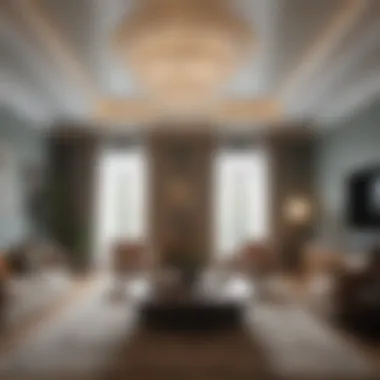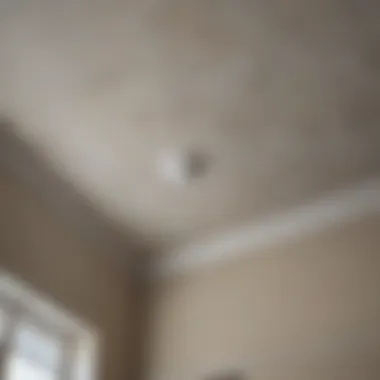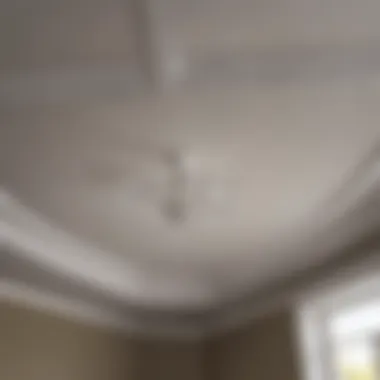Expert Guide to Selecting Ceiling Paint


Intro
Choosing the right ceiling paint can significantly influence the overall atmosphere of a room. While often overlooked, the ceiling plays a crucial role in the visual perception of a space. It has the ability to enhance or diminish the effects of other colors and design elements within the room. Understanding how to match ceiling paint to various themes is essential for creating a harmonious environment.
This guide aims to provide targeted insights for homeowners and design enthusiasts. It highlights color harmony, paint types, and practical application techniques. Additionally, it delves into color psychology and offers tips to maintain consistency across different areas.
Key Insights and Trends
Current trends in interior design
In interior design today, there is a noticeable shift towards creating cohesive and inviting spaces. Accent ceilings, for instance, are becoming increasingly popular. Using a color different from the walls can add depth and character. Soft whites and muted pastels are favored for a clean, modern look. Meanwhile, bolder colors are often chosen for more eclectic or dramatic themes.
Another trend is the integration of natural elements in color choices. Earthy tones, reminiscent of the outdoors, are chosen to create a calming effect. These colors can enhance the livability of a room. Neutral ceilings often provide a perfect backdrop for vivid wall colors or elaborate decorative elements.
Practical Tips and How-To Guides
- Identify Your Style: Before selecting a ceiling paint, assess the overall theme of the space. Is it contemporary, minimalist, or more traditional? Matching the ceiling paint effectively begins with understanding the room's purpose and aesthetic.
- Choose the Right Color: Opt for colors that complement your walls and furnishings. Depending on your taste, a lighter ceiling often creates an illusion of height, while darker colors may provide warmth and intimacy.
- Consider Lighting: Natural and artificial light significantly alters how a color appears. Test paint samples in different lighting conditions to ensure satisfaction with the chosen hue.
- Select the Appropriate Paint Type: Different ceiling materials require specific types of paint. For example, flat ceiling paint works well on drywall and plaster, while semi-gloss or satin finishes can highlight decorative ceilings or moldings.
- Maintain Consistency: If painting multiple rooms, consider a consistent ceiling color throughout for a seamless transition. This approach maintains visual fluidity.
Remember: The ceiling is not merely a fifth wall but an essential aspect of spatial design. Its color choice can Alter perceptions and establish a room's mood.
Successfully choosing a ceiling paint involves understanding various elements, including current trends, color psychology, and technical aspects of painting. As we explore further, this guide will assist in creating spaces that are aesthetically pleasing and comfortable.
Understanding Ceiling Paint
Understanding ceiling paint is essential for anyone looking to enhance the aesthetics of their living spaces. Ceilings often go unnoticed, yet they play a pivotal role in the overall design of a room. The right ceiling paint can create a sense of openness, add warmth, or contribute to an elegant ambiance. This section explores the key elements of ceiling paint, its purpose, and the characteristics that set it apart from standard wall paint.
Definition and Purpose
Ceiling paint refers to a specific type of paint formulated for use on ceilings. Generally, its primary purpose is to provide a uniform finish that can conceal imperfections and provide an even tone throughout an expanse. Unlike wall paint, ceiling paint often has a flat or matte finish to minimize reflections, which can be distracting in spaces where natural light plays a role. The importance lies in its ability to unify the room's design while offering practical benefits, such as being less prone to showing imperfections.
Characteristics of Ceiling Paint
When selecting ceiling paint, understanding its characteristics is vital. This can encompass various aspects, such as finish options, durability, and ease of application. Each characteristic holds significance in achieving the desired look and feel.
Finish Options
Finish options denote the sheen level of the paint. Ceiling paints typically come in flat or matte finishes, which deter light reflections. A key characteristic of the flat finish is its ability to hide flaws on the ceiling surface. A beneficial aspect of this option is that it preserves a sense of depth in a room. However, it is worth noting that flat paints may be less washable than glossier options.
Durability
Durability is a critical consideration when opting for ceiling paint. A key trait is its resistance to stains and washability. Ceiling paints are usually formulated to withstand the rigors of changing environments, making them a popular choice. A unique feature is that many products include mildew-resistant properties, ensuring longevity in humid areas. However, some may find that more durable options come with a higher price point.
Ease of Application
Ease of application relates to how manageable the paint is during the painting process. Many ceiling paints are designed for easy rolling and spreading, which can save time and effort. Their viscosity helps prevent drips, allowing for a smoother finish. A notable characteristic of these paints is that they are often formulated to dry quickly, allowing for faster project completion. However, achieving optimal results may still require careful surface preparation and the appropriate tools.
Color Theory and Its Impact
Understanding color theory is essential when selecting ceiling paint. It influences not just aesthetic choices, but also how a space feels and functions. Color choices can affect mood, perception of space, and overall harmony within the room. Thus, grasping the fundamentals of color theory creates opportunities for creating atmospheres that enhance comfort and style.
Understanding Color Wheel Basics
A color wheel is a visual representation of colors and their relationships. It typically includes primary colors (red, blue, yellow), secondary colors (green, orange, purple), and tertiary colors. The wheel is instrumental in understanding complementary colors, which are opposite each other on the wheel, and analogous colors, which sit next to each other. Using this tool can simplify the process of matching ceiling paint to designs. For instance, if the walls are painted orange, a cool blue ceiling might create an appealing contrast.
Warm vs. Cool Colors


Colors can be categorized as warm or cool. Warm colors include reds, oranges, and yellows, often bringing energy and vibrancy to a room. Cool colors, like blues, greens, and purples, are usually calming and soothing. Choosing the right temperature of color for your ceiling can either amplify or diminish the perceived height of the space. For example, a warm ceiling can make a room feel cozy, while a cool ceiling can give an illusion of added space.
Psychological Effects of Colors
Colors have significant psychological effects that can influence emotions and reactions.
- Warm Colors: Often evoke feelings of warmth and excitement. They are great for social areas like living rooms or kitchens where interaction is frequent.
- Cool Colors: Generally promote tranquility and calmness, making them a perfect choice for bedrooms or study areas.
It is crucial to consider these effects when selecting ceiling paints. A deep blue ceiling can provide a serene vibe, while a bright yellow may energize the space. Ultimately, aligning color choices with the desired emotional response is vital.
"The impact of color goes beyond the visual; it profoundly influences human behavior and mood."
Utilizing color theory effectively allows for more than just aesthetic appeal; it fosters environments that resonate with the intended experience. Understanding these fundamental aspects can profoundly enhance the impact of your ceiling paint choices.
Choosing the Right Color for Your Ceiling
Selecting the right color for your ceiling is crucial in creating a cohesive look in any room. The ceiling color can affect how spacious or cozy a room feels. It can enhance or clash with the wall colors and overall design theme. Beyond aesthetics, it can influence the mood and ambiance of the space.
One key benefit of choosing the right ceiling color is the ability to manipulate the perception of height. Light colors can reflect more light, making a low ceiling appear higher. Conversely, darker shades can create a more intimate setting, which might be preferable in bedrooms or cozy areas. Thus, considering the room functionality is vital.
Considering Room Functionality
When selecting a ceiling color, the room's purpose significantly influences your choices. Different spaces often call for different atmospheres. In kitchens and dining areas, light colors can make the environment feel more open and airy. In contrast, movie rooms or lounges may benefit from deeper, richer hues that foster a snug atmosphere.
Here are considerations to assess:
- Purpose of the Room: A room used for relaxation should have calmer tones, while active areas might thrive under vibrant colors.
- Natural Light: Rooms with ample natural light can tolerate darker options, while those lacking light might need brighter shades to inject energy.
Matching Ceiling Paint with Wall Colors
A well-coordinated ceiling color can enhance the overall aesthetic. Matching the ceiling paint with wall colors involves understanding principles of contrast and harmony.
Contrast and Harmony
Contrast and harmony are critical in achieving a balanced look. Contrast involves pairing different colors to create visual interest. For example, a bright white ceiling might sharply contrast with dark gray walls, creating a striking effect. This method is beneficial for making features stand out.
A strong characteristic of contrast is boldness. It can draw attention to unique architectural elements or furnishings. However, the challenge with high contrasts is achieving a harmonious balance. Too much contrast can become overwhelming, leading to a disjointed feeling in the space.
Monochromatic Schemes
Monochromatic schemes involve using varying shades of the same color. This approach can produce a sophisticated and cohesive appearance. A light sky blue ceiling paired with mid-tone blue walls can make a room feel serene and connected.
A key characteristic of monochromatic schemes is their simplicity. This approach is popular due to its ease of matching colors while providing subtle depth. However, this scheme may lack excitement, so introducing textures can add necessary visual interest.
Influence of Natural Light
Natural light plays a crucial role in how ceiling colors appear in a space. The amount and direction of light can alter color perception. For instance, a room that receives morning sunlight might show a warm tone in the ceiling, while an evening setting may highlight cooler hues.
Selecting colors that respond well to the light available in the room is essential. Testing paint swatches throughout the day can provide insights on how different shades transform under varying light conditions.
Considering these elements when choosing ceiling color can greatly enhance the overall harmony and function of a space.
Technical Aspects of Ceiling Painting
Understanding the technical aspects of ceiling painting is crucial for achieving a high-quality finish. The tools, materials, and techniques directly impact the final aesthetic and functionality of your painted ceiling. By selecting the right equipment and implementing proper procedures, you can ensure that the project goes smoothly and yields satisfactory results. This section will explore some of the essential elements involved in effectively painting ceilings.


Selecting the Right Tools and Materials
Choosing appropriate tools and materials is a fundamental step in ceiling painting. Each tool has unique characteristics that can significantly affect the outcome of the project. Having the right equipment can minimize labor and maximize efficiency.
Brushes and Rollers
Brushes and rollers are two of the most commonly used tools in ceiling painting. The primary benefit of using rollers is their ability to cover large areas quickly. They can hold a significant amount of paint, allowing for even distribution across the surface. This efficiency makes them a preferred choice for many homeowners and professional painters alike.
Brushes, on the other hand, are ideal for detail work and edges, especially in areas where precision is necessary. They can reach corners and tight spots that rollers cannot effectively cover. A combination of both can yield the best results.
Key Characteristics:
- Rollers are efficient for large areas.
- Brushes offer detailed precision.
One unique feature of rollers is their variety in nap thickness, influencing how texture will appear on the ceiling. Thicker naps can provide a more textured finish, while thinner naps are suited for smoother surfaces.
However, brushes tend to require more meticulous handling, which could slow down a large-scale project. It’s important to use high-quality brushes and rollers to avoid shedding bristles or uneven application.
Paint Sprayers
Paint sprayers offer an alternative method for applying paint, and they have gained popularity for their speed and ability to create a smooth finish. Sprayers can effectively cover intricate designs, reaching crevices that brushes and rollers may struggle with. This can be a significant advantage when dealing with textured ceilings.
Key Characteristic:
- Ability to reach intricate designs effortlessly.
One of the standout features of paint sprayers is their adjustable spray pattern, allowing users to tweak the application style to suit their specific needs. They also reduce the likelihood of overlap marks, a common issue with rollers and brushes.
Yet, sprayers can produce overspray, leading to wasted paint and a need for careful masking of surrounding surfaces. They require more preparation in terms of setup and cleanup compared to traditional tools. Understanding these dynamics is helpful in determining if a paint sprayer is right for your ceiling project.
Preparation Steps Before Painting
Proper preparation before painting can make or break the final result. Ensuring that the surface is clean and primed is vital to achieving an even application and good adhesion.
Surface Cleaning
Surface cleaning is essential for preparing your ceiling for paint. Any dust, dirt, or grease can prevent paint from adhering properly, leading to peeling or flaking over time. A clean surface ensures that the paint can bond effectively, which is critical for longevity.
Key Characteristic:
- Removes debris that could affect adhesion.
Utilizing a vacuum or damp cloth is often recommended. It is straightforward but essential in maintaining paint integrity. Neglecting this step can lead to regrettable results, hence emphasizing its importance in any ceiling painting project.
Primer Application
Applying a primer before painting serves to enhance the overall color and durability of the finish. Primers help create a uniform surface, especially when dealing with porous or stained ceilings. They prepare the base so that the final coat of paint can achieve its intended look.
Key Characteristic:
- Enhances paint adhesion and durability.
A unique feature of primer is its ability to block stains, which is beneficial when painting over previously damaged areas. While some might consider skipping the primer, doing so could result in uneven color or reduced durability, compromising the entire project. It’s a small step that yields significant benefits.
Application Techniques for Consistency


Achieving consistency in application is crucial to avoid streaks and mismatches. Techniques such as rolling in a ‘W’ pattern can help distribute paint evenly, while maintaining a wet edge minimizes visible lines. Taking your time and considering the methods of application can lead to impressive, professional-quality results.
By understanding these technical aspects, you set a solid foundation for a successful ceiling painting endeavor.
Post-Painting Considerations
Understanding post-painting considerations is essential in ensuring that your ceiling painting project delivers the desired results over time. After you have carefully selected the right paint and applied it, evaluating and maintaining the work is crucial for preserving both appearance and durability. This phase includes assessing the results, addressing any issues, and implementing a maintenance schedule. Each aspect plays a vital role in extending the life of your painted ceiling and enhances overall aesthetic appeal.
Evaluating the Finished Product
Identifying Issues and Solutions
Once the paint has dried, taking time to closely inspect the ceiling is important. Look for issues like uneven texture, stains, or color inconsistencies. Identifying these problems early can save time and effort later. Solutions may vary from touch-ups to complete repaints, depending on the severity of the issue. The key characteristic of identifying problems is being thorough in the evaluation process.
This aspect is beneficial for ensuring the quality of your work. Addressing minor imperfections can result in a significant improvement in appearance. A well-finished ceiling enhances the overall vibe of the room. However, overlooking these details can lead to a subpar final product.
Touch-Up Techniques
When minor imperfections are found, employing effective touch-up techniques is crucial. Using a brush or roller that matches your original application tools can help achieve uniformity. The primary advantage of this approach is that it allows for precise application, especially in hard-to-reach areas or on textured surfaces.
Additionally, a proper touch-up can avoid larger repainting jobs in the future. This technique is a popular choice in the interior design community because it allows for easy maintenance. However, it requires skill to not exacerbate the issue. Care must be taken to blend any new paint seamlessly.
Maintaining Painted Ceilings
Cleaning Methods
Regular cleaning methods are a key part of maintaining the aesthetics of painted ceilings. Many homeowners overlook this aspect, which can lead to dust and grime buildup. This buildup can dull the paint and create a less appealing environment.
A simple approach involves using a damp cloth for light cleaning or a soft brush attachment for your vacuum cleaner. This method is beneficial because it preserves the finish without the need for harsher chemical cleaners that could damage the paint. However, it demands a commitment to a regular cleaning schedule to keep ceilings looking fresh.
Periodic Touch-Ups
Over time, wear and tear will affect any painted surface. Therefore, implementing periodic touch-ups is necessary to maintain appearance. This practice involves being proactive rather than reactive. Regularly inspecting your ceilings can help catch imperfections and address them before they worsen.
The feature of periodic touch-ups lies in their preventive nature. By routinely assessing and addressing any wear, you ensure the longevity of the ceiling paint. However, some homeowners may find it tedious to maintain this routine. Balancing time and upkeep can be a challenge, but the benefits far outweigh the drawbacks.
"Regular maintenance not only enhances aesthetics but prolongs the life of your ceiling paint, ensuring it continues to complement your living space effectively."
Special Considerations for Different Ceiling Types
When it comes to painting ceilings, different styles and structures require specific approaches. Understanding these variations is crucial for achieving the desired aesthetic and functional results. Matters such as texture, height, and architectural elements can significantly impact color choice, paint application, and the overall visual harmony of a room. Homeowners and design enthusiasts must recognize these differences to ensure a successful ceiling paint project that enhances their living environment.
Textured Ceilings
Textured ceilings, often present in older homes or settings aiming for a distinctive aesthetic, pose unique challenges and opportunities. When matching paint to a textured ceiling, consider the texture's impact on light reflection and color perception. Some textures might diffuse light, making colors appear softer, while others can create shadows that change the ceiling's look throughout the day.
When painting textured ceilings, it's essential to select a paint with good coverage and adhesion properties. If the texture is heavy, like popcorn or knockdown, using a spray application can provide better coverage than traditional brushes or rollers. Moreover, consider using a color that complements the texture rather than trying to overpower it. Lighter hues can soften the appearance, while darker shades may emphasize the texture.
Vaulted and High Ceilings
Vaulted or high ceilings present a dramatic feature in any room but require careful consideration for painting. The height can make it difficult to achieve uniform color coverage and consistency, leading to an uneven appearance, especially if the painter cannot access every angle. When selecting paint colors, it's vital to remember that high ceilings can create perception issues; lighter colors can enhance the sense of spaciousness, while darker tones may create a more intimate feel, even if that is not the intent.
Using extension poles with rollers can help reach elevated areas. For those with vaulted ceilings, consider a two-tone approach. This means using a different color for the upper parts compared to the walls. It adds depth, draws the eye upward, and enhances the architectural interest of the space.
Crown Moldings and Architectural Features
Crown moldings and other architectural features may require special attention during the ceiling painting process. These elements often deserve their distinct treatment to highlight their significance within the room. Choosing a paint color that contrasts appropriately with the crown molding can add elegance and depth. For example, if the molding is painted white, a soft pastel ceiling can create a harmonious balance.
It's important to use fine brushes to carefully paint around these features, ensuring clean lines without overspill. Additionally, the finish of the paint can greatly impact the overall look. A satin or semi-gloss finish on moldings can create a subtle contrast with a matte ceiling, allowing these features to stand out attractively.
"In design, attention to detail reflects the overall vision. Special considerations for ceiling types are vital in achieving that vision."
By acknowledging the specific considerations related to textured ceilings, vaulted spaces, and decorative features, one can ensure that the painting project aligns with the intended design goals. A thoughtful approach brings out the best in the ceiling, enhancing the entire room's aesthetic and maintaining the coherence of the overall decor.



